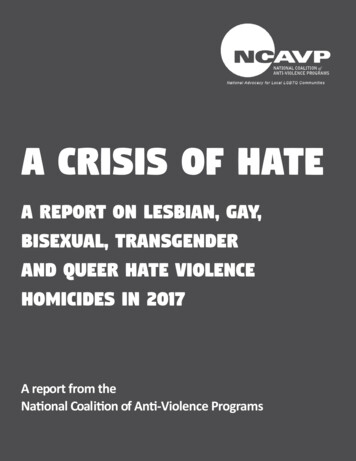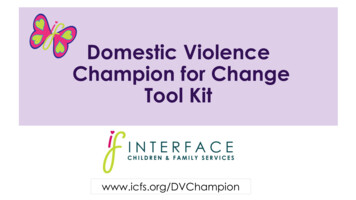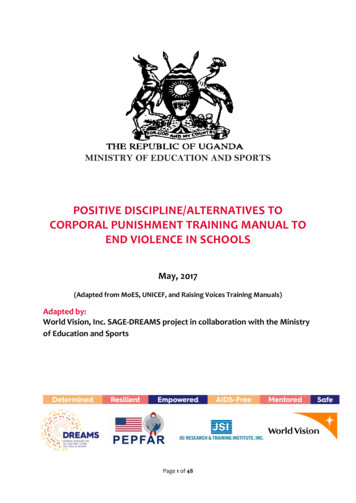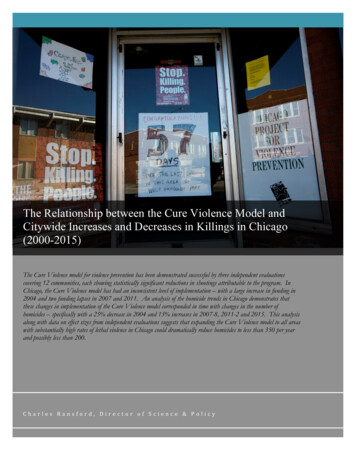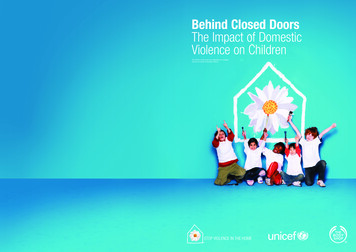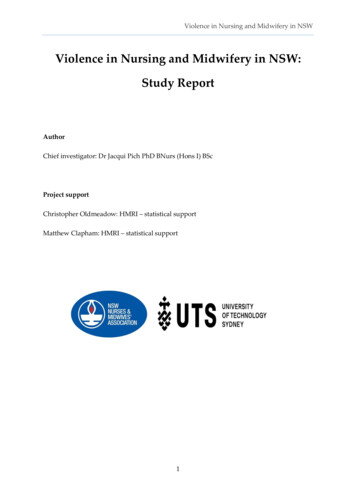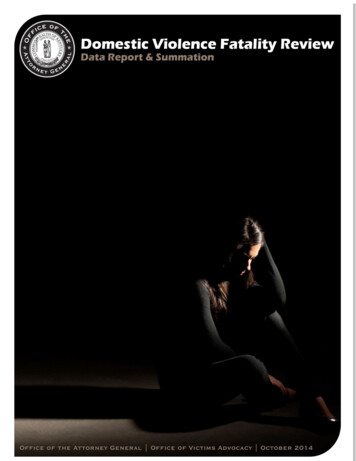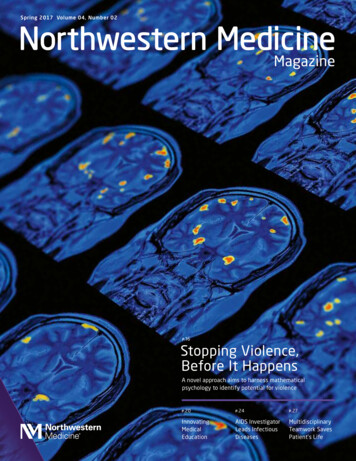
Transcription
Spring 2017 Volume 04, Number 02P.16Stopping Violence,Before It HappensA novel approach aims to harness mathematicalpsychology to identify potential for violenceP.20P.24P.27InnovatingMedicalEducationAIDS InvestigatorLeads InfectiousDiseasesMultidisciplinaryTeamwork SavesPatient’s Life
ADDRESS ALL CORRESPONDENCE TO:Northwestern UniversityFeinberg School of MedicineOffice of Communications420 E. Superior StreetRubloff 12th floorChicago, IL 60611Call or e-mail us at 312.503.4210 ormedcommunications@northwestern.edu 2016 Northwestern University.Northwestern Medicine is a federallyregistered trademark of NorthwesternMemorial HealthCare and is used byNorthwestern University.ROOPAL KUNDU, ’02 MD (LEFT), ASSOCIATE DEAN FOR ADMISSIONS AND THEJACOB R. SUKER, MD, PROFESSOR OF MEDICAL EDUCATION AND DERMATOLOGY,CONGRATULATES ONE OF HER MENTEES IN DERMATOLOGY, FOURTH-YEARMEDICAL STUDENT JELENA VASIC (RIGHT), ON MATCH DAY.
Northwestern MedicineMagazineSPRING 2017VOLUME 04, NUMBER 0202 Northwestern Medicine Leadership MessageHow We’re Transforming Healthcare Through ResearchCampus NewsMAGAZINE.NM.ORG03 Rankings Place Feinberg Among Top Medical Schools04 Medical Students Celebrate Match Day 201706 Medical Students and Physicians Volunteer Skills at Devon ClinicNorthwestern Medicine Magazine ispublished quarterly for alumni and friendsof Northwestern University FeinbergSchool of Medicine, NorthwesternMemorial HealthCare and the McGawMedical Center of Northwestern University.Material in Northwestern Medicine Magazine maynot be reproduced without prior consent andproper credit.07 Northwestern Medicine Expands Bluhm Cardiovascular Institute08 Potocsnak Gift Supports Biomedical Research Center09 RIC’s Shirley Ryan AbilityLab, First-Ever ‘Translational’ Research Hospital, Opens10 Research Briefs12 Media Spotlight14 Faculty Awards and Honors16 FeaturesWard Rounds (Alumni) News30 Introducing a New MAAB President32 Progress Notes37 The Physician’s PrivilegeE XE C U T I V E D I R E C T O RO F C O M M U N I C AT I O N SNicole MladicEDITORNora DunneE D I T O R I A L A S S I S TA N TAnita ChaseCONTRIBUTING WRITERSBob KronemyerBridget KuehnMarla PaulSarah PlumridgeCheryl SooHooMegan WashburnAnna WilliamsEDITORIAL BOARDF. Douglas Carr, ’78 MDCarla Hightower, ’87 MD,’91 GMEJennifer Hobbs, ’07 PhDKerry Humes, ’90 MDThomas Pitts, ’76 MDPaloma Toledo, ’03 MD/MPHBecca TrantowskiFarrell, ‘00 PT,‘02 DPTEric G. Neilson, MD, DeanAlan Krensky, MD, ViceDean for Developmentand Alumni RelationsBabette Nyka, Director,Alumni Relations38 Fighting Bacterial Pathogens40 In Memoriam and Upcoming EventsSTOPPING VIOLENCE,BEFORE IT HAPPENSA L U M N I A S S O C I AT I O NJames P. Kelly, ’73 MD,PresidentRishi Reddy, ‘00 MD,President-electA novel approach aims to harness mathematicalpsychology to identify potential for violenceADDITIONALPHOTOGR APHYNathan Mandell: insidecover, 4, 5Bruce Powell: 24Sarah Plumridge: 16, 18,21-23, back inside coverJim Prisching: 3, 22David Salzman, MD: 20Anna Williams: 6P.16DESIGNFirebelly ile studying brain reward circuitry(such as the amygdala activity pictured), HansBreiter, ’88 MD, stumbled upon a discovery that ledto a mathematical framework for human emotion.Read about how he applies this to violenceprevention on P.16.C O V E R A R T:learning translates toclinical ENGTHIN NUMBERSMultidisciplinaryteamwork savespatient’s lifeTaiwo brings international perspectiveto l Content OnlineImage PRING 2017 1
Northwestern Medicine LeadershipMessage: How We’re TransformingHealthcare Through ResearchIn February, nearly 300 of our principalinvestigators gathered in a hotel in downtown Chicago to contemplate the futureof Feinberg’s research enterprise. Workingtogether, these scientists and physicianscientists spent the day brainstormingideas for the medical school to prioritize inthe next five years.During nearly eight hours and threerounds of discussions, facilitators recordedhundreds of thoughts and suggestions. Aftereach round of dialogue, ideas were projectedonto screens around the room, refined, votedupon and ranked. Topics like epigenetics,community partnerships, big data and personalized medicine using stem cells rose tothe top during the final ranking process.Now we must reflect on these ideasand decide how we can best build on ourexisting strengths to continue advancing ourresearch to transform healthcare. Undoubtedly, this will involve increasing the size ofour faculty, ensuring we have the space andinfrastructure to support that growth, andsolidifying collaborations across Feinbergand other schools at Northwestern University. Research exploring how we can elevatethe way we deliver medical education —an area that translates directly to clinicaloutcomes — will also remain a priority for us.(See p.16 for a story about our exciting simulation-based medical education research.)2 NORTHWESTERN MEDICINE MAGAZINEAnother critical key to our success is partnering withour clinical affiliates, from Northwestern Medicine and beyond. Each is a laboratory to undertake research. We knowthat only by working together can we enhance quality ofcare; attract new patients to participate in clinical trials;and improve outcomes with better diagnostics, bettertherapies and by using big data analytics and precisionmedicine tools. It’s no coincidence that our research growthover the last five years has occurred as our clinical partnersexpanded, too. (See p.27 to read how a multidisciplinaryteam of our physicians took collaboration to heart to savea patient with a highly unusual complication post surgery.)Visualizing where we want to go requires thinkingabout how far we’ve come in just half a decade: In 2016,Feinberg received 443.1 million in research awards, a40 percent increase from 2012. We also ranked 16th inNational Institutes of Health funding among all American medical schools, up from 20th in 2012 and 39th in2002. Feinberg is now ranked 17th among the nation’sbest medical schools, and Northwestern MemorialHospital 8th among hospitals, according to U.S. News& World Report. These impressive facts and figuresconfirm that we are well on our way to solidify our placeas an elite medical school for years to come.This promise was on display in February at the retreatand again in April at our annual Research Day, where morethan 400 students, trainees, staff and faculty proudlypresented the findings from their projects and solicitedfeedback to make their work even stronger. The recordbreaking participation in this event celebrating research,the energy and comradery palpable in the conversationsthat took place that day, painted a striking picture of theway we approach research here at Northwestern Medicine.FEINBERG RECEIVED 76.1MIN CLINICAL TRIALS FUNDINGIN 2016, UP 72% FROM 2012.FEINBERG RECEIVED 443.1MIN RESEARCH AWARDS IN 2016,A 40% INCREASE FROM 2012.FEINBERG GENERATES68% OF ALL RESEARCH DOLLARSAT NORTHWESTERN UNIVERSITY.With warm regards,Eric G. Neilson, MDVice President for Medical AffairsLewis Landsberg DeanDean M. HarrisonPresident and CEONorthwestern Memorial HealthcarePATIENTS AND VOLUNTEERSTAKE PART IN CLINICAL TRIALSAND RESEARCH STUDIES ATFEINBERG EACH YEAR.
Rankings PlaceFeinberg AmongTop Medical SchoolsWRITTEN BY:Anna Williams17TH IN US NEWS RANKINGSNorthwestern University Feinberg School of Medicine has maintained its standing among the best research-oriented medicalschools, at 17th in the nation, according to the latest U.S. News &World Report rankings.This is the tenth year in a row Feinberg has placed in the top 20research-oriented medical schools.“Feinberg continues to distinguish itself as a world-classinstitution for medical education and research,” said Eric G. Neilson,MD, vice president for Medical Affairs and Lewis Landsberg Dean.“Our reputation is a testament to the dedicated work of our faculty,staff and students, and their tireless pursuit to improve humanhealth through innovative research and academic excellence.”Three specialty programs were also recognized as among thebest in the nation, with women’s health rising to 8th place, anall-time high; internal medicine rising two spots to 15th; andpediatrics maintaining its place at 14th.The U.S. News rankings are based on survey assessmentscompleted by deans and senior faculty at peer institutions, as wellas National Institutes of Health (NIH) research activity and studentselectivity, among other factors. The magazine surveyed thenation’s 140 fully accredited medical schools and 30 schools ofosteopathic medicine.16TH IN NIH RANKINGSFeinberg rose to 16th place among U.S. medical schools in fundingfrom the NIH in 2016. These rankings are reported annually bythe Blue Ridge Institute for Medical Research.The Blue Ridge analysis represents grants awarded betweenOctober 1, 2015, and September 30, 2016. This year is Northwestern’s highest ranking to date. It represents an increase of two spotsover 2015 and five spots over 2012, when the medical school wasranked 21st in the nation.Individual departments at Feinberg also ranked highly in the report:Twelve departments ranked among the top ten in their specialty forNIH funding, while an additional two ranked in the top 20.Award figures are obtained by Blue Ridge from the ResearchPortfolio Online Reporting Tools at the NIH. The report’s calculations include direct and indirect costs, but do not include contractsor other specialized mechanisms.DEPARTMENTS IN TOP 20 FORNIH FUNDING12356891017ST» » PUBLIC HEALTH (MEDICAL SOCIAL SCIENCES ANDPREVENTIVE MEDICINE)ND» » OBSTETRICS & GYNECOLOGY» » UROLOGYRD» » CELL & MOLECULAR BIOLOGY» » PHYSICAL MEDICINE & REHABILITATIONTH» » NEUROLOGYTH» » DERMATOLOGYTH» » NEUROLOGICAL SURGERY» » PHYSIOLOGYTH» » SURGERYTH» » PHARMACOLOGYTH» » INTERNAL MEDICINE» » OTOLARYNGOLOGYSPRING 2017 3
CAMPUS NEWSMedical StudentsCelebrate Match Day 2017WRITTEN BY:Anna WilliamsSee more photos fromMatch Day 2017 atmagazine.nm.org.On March 17, Feinberg’s fourth-year medical students tore opentheir white envelopes and learned where they will spend their firstyears as physicians.Match Day, an annual tradition held on the third Friday of March,is the day when all fourth-year students across the country find outwhere they will train as residents for the next three to seven years.At Northwestern, the room erupted in cheers at 11:30 a.m. asthe envelopes were opened in unison. The class of 2017, surrounded by friends, family and faculty, celebrated the success oftheir medical school journey and the beginning of the next phaseof their medical careers.“The atmosphere here today was incredible. It felt like the roofwas going to lift off with all the energy,” said Richard Greendyk,who matched in internal medicine at New York-Presbyterian Hospital at Columbia University Medical Center. “Everyone was incrediblyhappy when they opened their letters, and this really wouldn’thave happened without all the phenomenal support we’ve gottenhere over the last four years.”Residency matches are made by the National Resident Matching Program (NRMP), which uses a computerized algorithm to pairgraduating medical students with available training positions at U.S.teaching hospitals. The model takes into account the top choicesof both the students and the residency programs. This year’s MatchDay was the largest in history, with a record 43,137 registered applicants vying for more than 31,000 residency positions.Mia Helfrich and Charles Qin entered the match as a couple.Both students matched in orthopaedic surgery, with Helfrich at theMcGaw Medical Center of Northwestern University and Qin at theUniversity of Chicago Medical Center. “It was very nerve-racking,4 MAGAZINE.NM.ORGstanding there with our envelopes before we counted down, butwe’re so happy we matched in the same city,” Helfrich said. “I’mreally looking forward to spending another five years training hereat Northwestern.”Parul Kathuria, an Honors Program in Medical Education student who has studied at Northwestern for the last seven years,also chose to continue her medical career at McGaw, where shematched in dermatology and internal medicine. “I’ve had someamazing mentors here in both the dermatology and internalmedicine departments, and I’m thrilled to be staying,” she said.“The Northwestern community is rich with such a wide variety ofstudents from all kinds of backgrounds. It really is a special place todo your training.”
19 %12 %9%BY FEINBERGINTERNALEMERGENCYPSYCHIATRYSTUDENTS WEREMEDICINEMEDICINETHE MOST POPULARSPECIALTIES CHOSEN8%PEDIATRICS7%OBSTETRICS ANDGYNECOLOGYBrittany Vieira celebrated her match atBrigham and Women’s Hospital in Boston,where she’ll begin her training as a plasticsurgeon. “I think Feinberg does an unbelievable job fostering exactly the personyou want to be. They let me learn medicaleducation exactly the way I needed to, and Ithink that freedom and support is what gotme into Harvard plastic surgery,” Vieira said.“It was an unbelievable moment today. Tohave that many people realize their dreamsin one second, in one room — there’s justnothing like it.”SPRING 2017 5
CAMPUS NEWSMedical Students and PhysiciansVolunteer Skills at Devon ClinicWRITTEN BY:Anna WilliamsEven in the midst of a busy schedule of basic science lectures,exams and clinical training, first-year medical student Marcus Byrdputs a priority on volunteering in health clinics around Chicago.“One of the reasons I chose to attend Northwestern was becauseof its prestigious education, and I thought it would be a disservicenot to share that education with patients who are, on average,disadvantaged,” he said. “I try to make time for volunteering asoften as I can.”On one snowy Sunday morning this winter, Byrd joined a groupof six Feinberg medical students and traveled north to Rogers Park,a neighborhood on Chicago’s Far North Side. There, at the IndianAmerican Medical Association of Illinois Charitable FoundationClinic (IAMACF) on Peterson Avenue, the students spent their daycaring for the area’s underserved patients.The IAMACF is one of seven community clinics staffed byFeinberg student volunteers throughout the city, from Chinatown to the West Side. At these “student-run clinics,” medicalstudents provide free healthcare to diverse patient populationsand practice their clinical skills under the guidance of a volunteerattending physician.At the IAMACF, students and physicians come largely fromFeinberg and Northwestern Medicine hospitals, but are also drawnfrom other local medical centers. Together, the volunteers providefree primary care services, medications and lab tests to the clinic’suninsured, predominantly South Asian patients. In a nod to thepatient population, the clinic is more commonly referred to as “theDevon Clinic,” after the nearby street stocked with South Asianrestaurants and businesses.Medical students are core to the clinic’s ability to provide care.Every Sunday from 10 a.m. until 2 p.m., the students meet privatelywith patients in six different exam rooms, taking detailed medicaland social histories, measuring vital signs, performing physicalexaminations, updating medical records, documenting medicationregimens and offering nutrition counseling for chronic conditionslike diabetes, hypertension and hyperlipidemia. After meeting withpatients, the students present case summaries and their recommendations to an attending physician, who provides input andprescribes medications and lab tests, if necessary.“This clinic would simply not run without medical students,” explained Rajan Shah, MD, health system clinician in the Departmentof Medicine, Division of General Internal Medicine and Geriatrics,who volunteers at the clinic with his wife, a physician at RushUniversity Medical Center. “As attending physicians, we are the6 NORTHWESTERN MEDICINE MAGAZINEFIRST-YEAR MEDICAL STUDENT MARCUS BYRD UPDATES A PATIENT’S MEDICAL RECORDS WHILE VOLUNTEERING AT THE INDIAN AMERICAN MEDICALASSOCIATION OF ILLINOIS CHARITABLE FOUNDATION CLINIC.consulting entity and we sign off on everything. But the medicalstudents are the foundation of care. They are creating a big changein people’s lives, even as trainees.”Feinberg students also serve as coordinators, helping managethe clinic, recruit other medical students and physicians, and orientnew volunteers.The medical students are thefoundation of care. They arecreating a big change in people’slives, even as trainees.Avni Bavishi, now a second-year student, served as a coordinator for the clinic last year. “I got involved with the Devon Clinicbecause I was excited about the opportunity to help an underserved population. As a coordinator, I also had the chance to see
Northwestern Medicine ExpandsBluhm Cardiovascular Institutewhat goes on behind the scenes in a freeclinic and got a deeper understanding ofhow vital it is that organizations like thisexist,” Bavishi said. “The experience gaveme great exposure to managing chronicdisease in a primary care setting andpractice with skills I’ll need for the restof my life.”“You do see some hard cases, andsometimes it can be stressful, but I love ithere,” added Ankita Devareddy, a first-yearstudent and one of four current co-coordinators at the clinic, who volunteered atIAMACF while an undergraduate studentat Northwestern, interpreting for patientswho spoke Hindi and Telugu. “This clinicreminds me of why I wanted to go intomedicine in the first place.”It’s a sentiment shared not only bystudents, but by the Feinberg faculty whovolunteer at IAMACF as well.“I feel so grateful to be able to do this,”Shah said. “Burnout can be a problem forsome physicians, but I feel that the fulfillment we receive from even just one dayhere at the clinic is exponential — becausewe’re doing what we went into medicinefor, and providing care for people whowould be turned away elsewhere. It’s reallya win-win that makes the whole communitybetter off.”A philanthropic gift of 2.5 million will support the expansionof the renowned Northwestern Medicine Bluhm CardiovascularInstitute with a new hub at Northwestern Medicine Central DuPageHospital in Winfield and clinical care services at NorthwesternMedicine Delnor Hospital in Geneva and Northwestern MedicineKishwaukee Hospital in DeKalb.“This expansion is a unique opportunity to offer the highestlevel of academic medicine and research in a community hospital setting,” said Patrick McCarthy, MD, executive director of theBluhm Cardiovascular Institute and chief of Cardiac Surgery in theDepartment of Surgery. “Developing true connections across theentire Northwestern Medicine health system to share talent andknowledge will ensure we are providing exceptional and all-encompassing cardiovascular care to all Northwestern Medicine patients.”The 2.5 million donation is composed of many unrestrictedgifts to the Northwestern Memorial Foundation from donors inthe community to Central DuPage and Delnor hospitals overmany years.The Bluhm Cardiovascular Institute was established in 2005under the leadership of McCarthy with a generous gift by Chicagoreal estate developer and philanthropist Neil Bluhm. Since then,Northwestern Memorial Hospital’s cardiology and heart surgeryprogram has gone from unranked to 6th nationally as rated by U.S.News and World Report. Northwestern Memorial is also currentlyranked first in the country for heart failure survival and second forheart attack and stroke survival in Medicare patients, the triplethreat of cardiovascular disease.“Creating this institute was the best investment I’ve ever made,”said Bluhm. “It is exciting to expand the geographical reach of theprogram to offer more patients access to leading-edge cardiac care,complex heart procedures and clinical trials close to home.”Six niche centers within the Bluhm Cardiovascular Institutewill be developed in the western suburbs with a focus on coronarydisease, heart failure, heart rhythm disorders, heart valve disease,preventive cardiology and vascular disease. The expansion will alsostreamline and enhance coordination for west suburban patientswho may require heart transplantation or other cutting edge treatment at Northwestern Memorial Hospital.Our alumni are active volunteers, too!On p.37, John Sager, ’91 MD, describeshis experience providing medical careto Syrian refugees.SPRING 2017 7
CAMPUS NEWSPotocsnak Gift SupportsBiomedical Research CenterWRITTEN BY:Marla PaulChicago industrialist John Potocsnak made a transformative giftto Northwestern University Feinberg School of Medicine in support of the Louis A. Simpson and Kimberly K. Querrey BiomedicalResearch Center.This gift brings the total contributions to the “We Will. The Campaign for Northwestern Medicine” to 1.5 billion in donations. The goalof the entire campaign for Northwestern Medicine is 1.75 billion.The donation names the new building’s lobby atrium the Potocsnak Family Lobby Atrium and a floor of research labs.“This generous gift from the Potocsnak family will help accelerate our pace of discovery, heighten the collaborative nature ofleading-edge research conducted at Northwestern and develop thenext generation of physician-scientists,” said Eric G. Neilson, MD,vice president for medical affairs and the Lewis Landsberg Dean atFeinberg. “John and Laura have been exceptional philanthropists formany years, and we are extraordinarily grateful for their unwavering support of our mission to transform human health.”The Potocsnak Family Lobby Atrium is a highly visible first-floorspace that will welcome the campus community and visitors tothe Simpson Querrey Biomedical Research Center and serve as asite for numerous events, poster sessions and other professionalgatherings. The lobby also will extend and expand the food courtcommons that is currently available to students, faculty and visitors to the Robert H. Lurie Medical Research Center.Additionally, each research floor of the Simpson QuerreyBiomedical Research Center will have more than 40,000 square8 MAGAZINE.NM.ORGTHE POTOCSNAKFAMILY LOBBYATRIUM WILL BE THEFIRST-FLOOR SPACEIN THE SIMPSONQUERREY BIOMEDICALRESEARCH CENTER.feet and 138 research benches for Northwestern scientists. Floors will house seniorprincipal investigators, technicians, laboratory assistants, postdoctoral students andresearch faculty.Potocsnak, the chief executive officerof Corrugated Supplies Co., and his wife,Laura, have been Northwestern donorsfor more than a decade. They establishedthe Potocsnak Family C.S.C. Professorship,which is held by Frank Palella, MD, ’90 ’92GME, professor of Medicine in the Division of Infectious Diseases.“It’s important for my family and me tomeaningfully support Chicago institutionslike Northwestern that are not only makingan impact locally, but also at national andinternational levels,” Potocsnak said. “I amproud to support Northwestern, and hopethat the research taking place here at Feinberg will make a real difference in people’slives and ultimately lead to cures.”When complete, the Simpson QuerreyBiomedical Research Center at Feinbergwill provide new space for biomedicalscientists working in cancer, heart disease,neurodegenerative disorders and genetics.It will help draw the most talented researchfaculty, doctoral students and postdoctoralfellows, and it will provide new research opportunities for medical students, residentsand clinical fellows on both the Evanstonand Chicago campuses.The “We Will” Campaign for Northwestern Medicine was launched to inspireand to provide crucial resources that willpropel innovation and excellence acrossthe academic medical center. Through thecampaign, Northwestern University Feinberg School of Medicine and NorthwesternMemorial Foundation are working togetherto raise 1.75 billion to provide crucial resources. All funds raised will count towardNorthwestern University’s overall campaigngoal of 3.75 billion.
RIC’s Shirley Ryan AbilityLab, First-Ever‘Translational’ Research Hospital, OpensWRITTEN BY:Megan WashburnRIC — now the Shirley Ryan AbilityLab — is oneof Feinberg’s primary clinical affiliates. Morethan 100 medical school faculty have privileges at the hospital, which hosts residents,fellows and medical students during theirphysical medicine and rehabilitation rotation.AN INSTALLATION BYARTIST PAE WHITE ONDESIGN: HDR GENSLER;PHOTOGRAPHY: HDR/DANSCHWALM (LEFT) AND DAVEBURK (RIGHT)THE 10TH FLOOR SKYLOBBY OF THE SHIRLEYRYAN ABILITYLAB.On March 25, the Rehabilitation Institute of Chicago (RIC) officiallybecame known as the Shirley Ryan AbilityLab as it opened itsdoors to a cutting-edge research hospital of the same name.Located at 355 E. Erie Street in Chicago, the 550 million,1.2-million-square-foot AbilityLab is the first-ever “translational”research hospital in which clinicians, scientists, innovators andtechnologists work together in the same space, 24/7, surrounding patients, discovering new approaches and applying research inreal time.“The Shirley Ryan AbilityLab is the only hospital in the worldwhere doctors focused on solving patient challenges now workside-by-side with scientists focused on finding cures,” said JudeReyes, chairman of the hospital’s board of directors. “The result isfocused discovery and innovation on behalf of patients, who willbe poised to achieve their best possible recoveries here.”The AbilityLab introduces its model of care through five Innovation Centers focused on areas of biomedical science withextraordinary promise:»»»»»Brain Innovation CenterSpinal Cord Innovation CenterNerve, Muscle & Bone Innovation CenterPediatric Innovation CenterCancer Rehabilitation Innovation CenterSPRING 2017 9
Research BriefsMore details on these studies are online atmagazine.nm.org.Lurie Cancer Centerto Lead Trial for RareCancer PatientsMolecule Stops FatalPediatric Brain TumorNorthwestern Medicine scientists found a molecule that stops thegrowth of an aggressive pediatric brain tumor called diffuse intrinsicpontine glioma (DIPG). Every year, about 300 children under the ageof 10 in the U.S. develop the fatal tumor.The study, published in Nature Medicine, is the result of collaboration between scientists at Feinberg and the Ann & Robert H. LurieChildren’s Hospital of Chicago.“To the best of our knowledge, this is the most effective molecule so far in treating this tumor,” said senior author Ali Shilatifard,PhD, Robert Francis Furchgott Professor of Biochemistry and Pediatrics. “Every other therapy that has been tried so far has failed.”The molecule works by detaching proteins called bromodomainproteins from their binding to a mutant protein, histone H3K27M,which is present in more than 80 percent of DIPG tumors. Shilatifard’s lab previously identified the pathway through which themutation causes the cancer in studies with fruit flies.In this study, scientists took DIPG tumor cell lines from an untreated pediatric patient, injected them into the brain stem of a mouseand then treated the engrafted human tumor with the molecule. Themolecule stopped the tumor cells from growing and forced them toturn into other types of cells, thereby halting the cancer’s growth.“This discovery is the perfect example of how we take basicscience discoveries and translate them to cure diseases at Northwestern Medicine,” said Shilatifard, who is also chair of Biochemistryand Molecular Genetics and a member of the Robert H. Lurie Comprehensive Cancer Center of Northwestern University.A novel national trial for people with noestablished alternative to treat their rarecancers is being co-led by NorthwesternMedicine investigators at the Robert H.Lurie Comprehensive Cancer Center ofNorthwestern University.The clinical trial, called DART, will offereligible cancer patients a combination of twoimmunotherapy drugs that help reactivatethe patients’ own immune system to fightcancer. The aim of the trial is to determineif the drugs, given in six-week cycles, cansignificantly shrink tumors.“The DART trial offers a vital safety netfor people with rare cancers who currentlyoften fall between the therapeutic cracks,”said Frank Giles, MD, chief and Johanna DobeProfessor of Hematology/Oncology in theDepartment of Medicine and one of fourprincipal investigators of the study.Many people with rare cancers — about20 percent of cancers diagnosed — aren’teligible for molecularly targeted cancertherapies because genetic testing of theirtumor doesn’t show a match for a specificdrug. When traditional chemotherapy fails,they often don’t have an established effective alternative.Rare cancers have less than a 6 in100,000 incidence per year. They includedozens of individual diseases, including cancers in nerves, glands, bones and skin.The DART trial is funded by the National CancerThe research was supported by grants RO1NS093079 and R35CA197569 from theInstitute. Bristol Myers Squibb is providing the studyNational Cancer Institute of the National Institutes of Health.drugs for the DART trial.10 NORTHWESTERN MEDICINE MAGAZINE
Overexpression of ProteinImproves Cardiac EfficiencyScientists revealed the role of a protein, SNRK, in cardiac tissuemetabolism, a finding that may lead to new insights in treatingheart failure.In a Nature Communications paper, the scientists show that overexpression of SNRK alters heart tissue by reducing its metabolism offatty acids and glucose, while retaining normal function.“This was quite surprising to us,” said lead author Hossein Ardehali, MD, PhD, professor of Medicine in the Division of Cardiology andof Pharmacology. “The heart usually uses about 70 percent fattyacids and 30 percent glucose. Under disease conditions, this ratioreverses. It has never been shown that the metabolism of both ofthese substrates are reduced simultaneously in a normal heart.”Using mouse models, the scientists further demonstrated thatmice overexpress
way we approach research here at Northwestern Medicine. With warm regards, Eric G. Neilson, MD Vice President for Medical Affairs Lewis Landsberg Dean Dean M. Harrison President and CEO Northwestern Memorial Healthcare Northwestern Medicine Leadership Message: How We're Transforming Healthcare Through Research FEINBERG RECEIVED 76.1M
